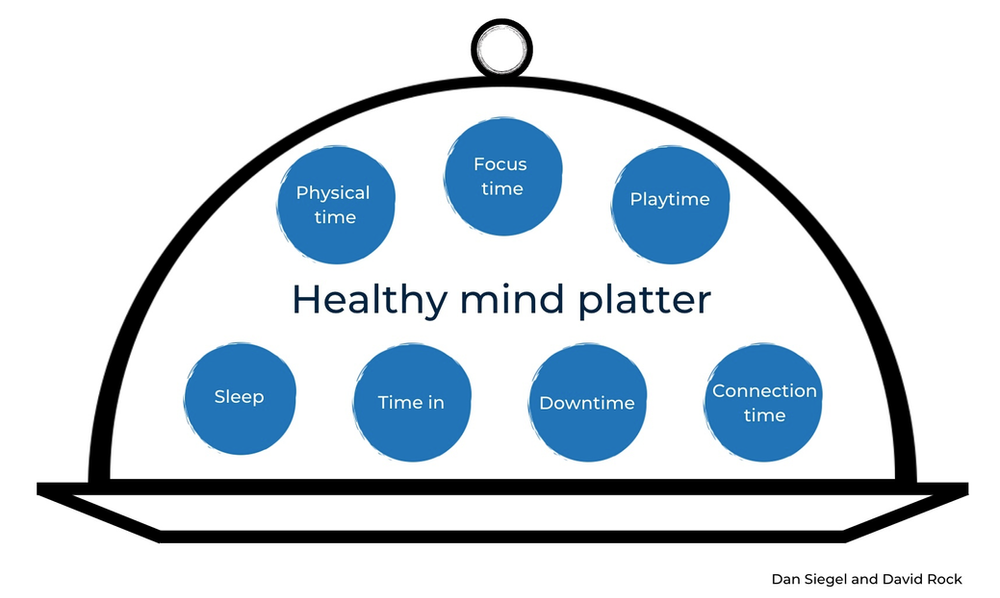29th April, 2020 • 3 min

Written by Coran Lui
12th May, 2022 • 5 min

Do you ever find it difficult to manage your stress and pressure at work? Maybe you have found it hard to motivate yourself, and are taking longer to get things done?
If you relate to this, you’re not alone. And if you don’t, chances are that you know someone in your team who does. These are all common signs of burnout at work.
Recent research has found that 79 percent of UK individuals have experienced burnout in their current job.
Unsurprisingly, mental health has become a priority for both individuals and organisations, especially as we adapt to the post-pandemic workplace. According to the Mental Health Foundation, positive mental health at work can improve productivity by up to 12%.
With this in mind, it is important to have structures in place to challenge work-related stress and burnout.
The healthy mind platter is a useful tool to help us create this structure:

We all know that in order to have a balanced, healthy diet, we need to consume a variety of different foods. And actually, the health of our mind is no different!
Research based on neuroscience and psychology has found that there is a platter of seven activities that, when done in a way that you find enjoyable and sustainable, provide a well-balanced “mental diet” contributing to a healthy mind.
As you read through the stages of the mind platter, rate yourself out of ten: where are you currently scoring on each of these?
Then, rate yourself again on where you would like to be. Do you want to do a bit more? A bit less?
1. Sleep

Over two thirds of adults are not getting enough sleep. Research has shown the importance of getting a recommended eight hours of sleep every night: a good night’s sleep improves memory, communication, focus, and attention.
And sleep is just as important (if not more important) for leaders.
Leaders who had a good night’s sleep achieve better results, are better at problem solving and supporting their team.
Are you getting enough sleep? Is there anything you can do to prioritise sleep more?n
2. Physical time
Physical activity doesn’t just help our physical health – it strengthens our brain as well.
Exercise can help reduce stress, help us recover from mental exhaustion, and significantly improve our brain function.
Can you build more habits around exercising? It could be as simple as going for a half hour walk at lunchtime.
3. Focus time

Do you look at your phone within an hour of waking up? Are you checking your emails even before you start your working day?
By doing this, we put ourselves in a reactive state, triggering our cortisol response (our stress hormone), making it difficult to concentrate for the rest of the day.
We need that focus time during our day, where we are able to get into deep work, into a state of “flow”, rather than trying to “power through” the day while being pulled between tasks.
How often do you think the average person checks their email or messages? Every half an hour? Every hour?
Six minutes. That’s around 80 times over the course of a typical workday!
Some ideas of how to achieve flow in light of this: avoid looking at your phone first thing in the morning, block out time in your calendar, or turn off your notifications for an hour. There are many ways to help you focus and get to your flow state.
4. Playtime
As the saying goes, “all work and no play…”
Having fun at work helps us get into a more positive and relaxed mindset, and helps our brain create new connections and build team trust.
Being in a happy work environment can empower us to generate more creative and innovative ideas and boost productivity.
Are you spending time having fun? This could be doing an activity with your team, playing with your children, going to a pottery class, or having a board games night.
5. Connection time
As humans, we instinctively seek connection with others and the world around us. Connection time increases oxytocin, the hormone linked with increased empathy and trust – which also reduces cortisol (the stress hormone from earlier!).
By connecting with each other, we not only remind ourselves of the reasons why we enjoy working together, but also give ourselves the opportunity to re-align our collective goals and shared values.
Are you spending time connecting with people and with nature? Have a coffee together virtually. Make time to have lunch together when you are in the office. Or even go for a walk in nature!
6. Downtime
Taking time off to recharge your batteries is key to a healthy mind.
This can be through breaks during the workday, blocking out time for lunch, or taking holiday.
Research shows that going on holiday not only improves our physical and mental health, it also improves our overall life satisfaction and significantly increases our productivity once we get back to work.nnDo you have downtime built as part of your daily schedule? Hold yourself accountable to take breaks during the workday and block out time in your calendar for lunch, if you don’t the chances are you won’t take a break.
Plan ahead – take the time and book in holidays, as it only becomes harder to take that time off if you wait. Also be sure to set clear expectations with your team when you are off!
7. Time in
With so much going on in our day to day lives, having personal reflective and meditative time can reduce our stress levels, and improve sleep quality and productivity.
“Time in” refers to the conscious, focused attention on ourselves, in the present moment. Rather than reflecting with the goal of changing or appraising a situation, we are taking a step back and becoming more mindful and accepting of our thoughts, feelings, and sensations.
Not only can time in improve our physical and mental health, but it can also have great emotional benefits, such as increased self-control, stress management, along with empathy and compassion.
Are you finding opportunities for time in? Practicing mindfulness, yoga, prayer and meditation can help focus and increase self awareness and focus.

Three key takeaways from the healthy mind platter
How to use the healthy mind platter to protect your team from burnout
While the healthy mind platter is an effective tool for individual self-management, you can also use it to help understand your team and build effective strategies to improve your workplace culture.
As we shared in our previous blog on how to engage your team, building a feedback culture and learning to share feedback effectively is important in creating behaviour change.
The healthy mind platter is one of the best tools we can use to have an open and honest conversation about wellbeing and burnout.
Sit down with your team, and have them rate themselves in each of these areas. Review where they are and where they want to be.
By doing so, you will be able to spot any signs of burnout and address them before they become an issue.